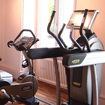Kenzo world
Intermediate level
Description
Materials
Main Aims
-
To provide practice of body parts and movement in the context of daily life and dancing
Subsidiary Aims
-
To provide accuracy speaking practice in a describing body parts and movements
-
To provide practice of language used for giving instructions
Procedure (60-88 minutes)
Divide students into two groups. Tell group A they will be practising an improvised speech and B that they will be observing the A students movements and that they need to remember how A moved and even to copy their movements. Pair up the students. Have them stand facing each other, about 2m apart, around the room not too close to another pair. Give A a topic like: what I did today before I arrived at the class, and one minute to talk. If B is brave they will copy the gestures and leaning movements, of not they will at least remember them. Ask B students to demonstrate what they saw A doing.
Show some pictures of face and body gestures on the screen and elicit their features and their function. Shrug, wink, blink, point, raise hand, cover mouth, etc dont know, get attention, etc Provide a few in words only and get students to find out the matching movement.
Break up the class into teams of 6ish. Explain that they will see a video and have to make notes on what happens. They can divide the video into sections or just try to collate their efforts into a full description. Play Kenzo world video - Start as woman stands up pause after a few seconds and clarify what you want using the first few actions (stand up, rub back of neck, wink etc) then play until about 5 seconds before the end. Depending on student level and preparedness you may need to break this up into several parts. Eventually, you should be ready to play the video once through uninterrupted and have students check their final lists. Ask students to demonstrate poses or movements they don't know how to describe. Collate a full list.
Consider the required body language for certain situations: Encouraging someone to speak socially, or addressing a group formally. Have students make suggestions for a list of life situations including sitting and standing. Discuss bad things like slouching and leaning or no eye contact etc.
A variety of games can be used to finish the class. Depending on the level, age and bravery of the class, teacher discretion is advised. Variations on twister, Simon says, or simply calling on students to adopt poses or actions you prescribe in order to stay in the game (wrong actions or too much hesitation results in sitting down and being out). This can be teacher-led at first but may work better transformed into a team game where students challenge each other to do things for points.

